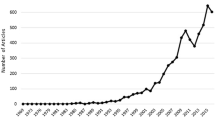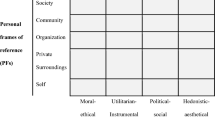Abstract
Scholars studying organizational reputation have demonstrated increased interest in understanding the way in which publics’ knowledge of an organization is related to its reputation. Research in this area has looked at variables related to media exposure, public prominence and/or familiarity. By reviewing the relevant literature, in this paper we aim to clarify conceptually the meaning of these various terms, the relationship between one another and with reputation. We conclude the paper by identifying emerging research and management implications.
Similar content being viewed by others
Notes
Examples of such terms include familiarity, (media) visibility, prominence, mind share, salience, media exposure, media coverage, (media) attention, awareness, knowledge, recognition, celebrity, top-of-mind (awareness), (direct) experience.
We decided to use Google Scholar, as it is a highly comprehensive database, often including more material than other traditional databases (e.g., Walker, 2010).
Table A1 contains the selected empirical papers; however, the written review also considers the discussions that have appeared in conceptual or theory papers.
Pfarrer et al. (2010) explain how (media) visibility has also been used synonymously with other concepts, such as, for instance, celebrity. However, according to their conceptualization, celebrity is defined both by high levels of media attention and positive affect (see also Rindova et al., 2006). Visibility is thus not sufficient in itself to determine celebrity. In support of this distinction, in their paper, Pfarrer et al. (2010) found that media visibility alone, compared with reputation or celebrity, has different (weaker) effects on investors’ reactions to earnings surprises.
Existing literature in the fields investigated here and in fields such as social psychology and sociology of mass media would allow to make predictions about the potential nature of the relationship between visibility and familiarity and as well as prominence and familiarity; however, given that this is a literature review, this is not the objective of the paper as we focus on reviewing the literature published in the field of reputation management and closely related areas.
References
Barnett, M.L., Jermier, J.M. and Lafferty, B.A. (2006) ‘Corporate reputation: The definitional landscape’, Corporate Reputation Review, 9 (1), 26–38.
Bergh, D.D., Ketchen, D.J. and Boyd, B.K. (2010) ‘New frontiers of the reputation-performance relationship: Insights from multiple theories’, Journal of Management, 36 (3), 620–632.
Boyd, B.K., Bergh, D.D. and Ketchen, D.J. (2010) ‘Reconsidering the reputation-performance relationship: A resource-based view’, Journal of Management, 36 (3), 1–22.
Brammer, S.J. and Millington, A. (2005) ‘Corporate reputation and philanthropy: An empirical analysis’, Journal of Business Ethics, 61 (1), 29–44.
Brammer, S.J. and Pavelin, S. (2006) ‘Corporate reputation and social performance: The importance of fit’, Journal of Management Studies, 43 (3), 435–455.
Bromley, D.B. (1993) Reputation, Image and Impression Management, John Wiley, Chichester.
Bromley, D.B. (2000) ‘Psychological aspects of corporate identity, image and reputation’, Corporate Reputation Review, 3 (3), 240–252.
Brooks, M.E. and Highhouse, S. (2006) ‘Familiarity breeds ambivalence’, Corporate Reputation Review, 9 (2), 105–113.
Brooks, M.E., Highhouse, S., Russel, S.S. and Mohr, D.C. (2003) ‘Familiarity, ambivalence and firm reputation: Is corporate fame a double-edged sword?’ Journal of Applied Psychology, 88 (5), 904–914.
Cable, D.M. and Turban, D.B. (2003) ‘The value of organizational reputation in the recruitment context: A brand equity perspective’, Journal of Applied Social Psychology, 33 (11), 2244–2266.
Carroll, C.E. (2004) ‘How the mass media influence perceptions of corporate reputation: Agenda-setting effects within business news coverage’, Doctoral Dissertation, University of Texas at Austin, TX, USA.
Carroll, C.E. (2010) ‘Should firms circumvent or work through the news media?’, Public Relations Review, 36 (3), 278–280.
Carroll, C.E. (2011a) ‘The role of the news media in corporate reputation management’, in, R.J. Burke, G. Martin and C.L. Cooper (eds.), Corporate Reputation: Managing Opportunities and Threats, Gower Publishing Company, Surrey, pp. 199–216.
Carroll, C.E. (2011b) Corporate Reputation and the News Media. Agenda Setting Within Business News Coverage in Developed, Emerging, and Frontier Markets, Routledge, New York.
Carroll, C.E. and McCombs, M. (2003) ‘Agenda-setting effects of business news on the public’s images and opinions about major corporations’, Corporate Reputation Review, 6 (1), 36–46.
Carter, S.M. (2006) ‘The interaction of top management group, stakeholder, and situational factors on certain corporate reputation management activities’, Journal of Management Studies, 43 (5), 1145–1176.
Coombs, W.T. (2007) ‘Protecting organization reputation during a crsis: The development and application of situational crisis communication theory’, Corporate Reputation Review, 10 (3), 163–176.
Deephouse, D.L. (2000) ‘Media reputation as a strategic resource: An integration of mass communication and resource-based theories’, Journal of Management, 26 (6), 1091–1112.
Fischer, E. and Reuber, R. (2007) ‘The good, the bad and the unfamiliar: The challenges of reputation formation facing new firms’, Entrepreneurship Theory and Practice, 31 (1), 53–75.
Fombrun, C.J. and Shanley, M. (1990) ‘What’s in a name? Reputation building and corporate strategy’, Academy of Management Journal, 33 (2), 233–258.
Fombrun, C.J. and van Riel, C.B.M. (2004) Fame and Fortune: How Successful Companies Build Winning Reputations, Financial Times/Prentice Hall, Upper Saddle River, NJ.
Gardberg, N.A. and Fombrun, C.J. (2002) ‘For better or worse – The most visible American corporations’, Corporate Reputation Review, 4 (4), 385–391.
Gardberg, N.A. and Newburry, W. (2013) ‘Who boycotts whom? Marginalization, company knowledge, and strategic issues’, Business and Society, 52 (2), 318–357.
Gatewood, R.D., Gowan, M.A. and Lautenschlager, G.J. (1993) ‘Corporate image, recruitment image, and initial job choice decisions’, Academy of Management Journal, 36 (2), 414–427.
Grunig, J.E. and Hung, C.F. (2002) ‘The effect of relationships on reputation and reputation on relationships: A cognitive, behavioral study’, Paper presented at the PRSA Educator’s Academy 5th Annual International, Interdisciplinary Public Relations Research Conference, Miami, Florida.
Highhouse, S., Brooks, M.E. and Gregarus, G. (2009) ‘An organizational impression management perspective on the formation of corporate reputation’, Journal of Management, 35 (6), 1481–1493.
Keller, K.L. (1993) ‘Conceptualizing, measuring, and managing customer-based brand equity’, Journal of Marketing, 57 (1), 1–22.
Kiousis, S. (2004) ‘Explicating media salience: A factor analysis of New York Times issue coverage during the 2000 U.S. presidential election’, Journal of Communication, 54 (1), 71–87.
Kotha, S., Rajgopal, S. and Rindova, V.P. (2001) ‘Reputation building and performance: An empirical analysis of the top-50 pure internet firms’, European Management Journal, 19 (6), 571–586.
Lange, D., Lee, P.M. and Day, Y. (2011) ‘Organizational reputation: A review’, Journal of Management, 37 (1), 153–184.
Luce, R.A., Barber, A.E. and Hillman, A.J. (2001) ‘Good deeds and misdeeds: A mediated model of the effect of corporate social performance on organizational attractiveness’, Business and Society, 40 (4), 397–415.
McCorkindale, T. (2008) ‘Does familiarity breed contempt? Analyses of the relationship among company reputation, company citizenship, and company personality on corporate equity’, Public Relations Review, 34 (4), 392–395.
Meijer, M.M. and Kleinnijenhuis, J. (2006) ‘Issue news and corporate reputation: Applying the theories of agenda setting and issue ownership in the field of business communication’, Journal of Communication, 56 (3), 543–559.
Mishina, Y., Block, E.S. and Mannor, M.J. (2012) ‘The path dependence of organizational reputation: How social judgment influences assessments of capability and character’, Strategic Management Journal, 33 (5), 459–477.
Mishina, Y., Dykes, B.J., Block, E.S. and Pollock, T.G. (2010) ‘Why ‘good’ firms do bad things: The effects of high aspirations, high expectations, and prominence on the incidence of corporate illegality’, Academy of Management Journal, 51 (4), 701–722.
Petkova, A.P., Rindova, V.P. and Gupta, A.K. (2012) ‘No news is bad news: Sensegiving activities, media attention, and venture capital funding of new technology organizations’, Organization Science, 24 (3), 865–888.
Pfarrer, M.D., Pollock, T.G. and Rindova, V.P. (2010) ‘A tale of two assets: The effects of firm reputation and celebrity on earnings surprises and investors’ reactions’, Academy of Management Journal, 53 (5), 1131–1152.
Philippe, D. and Durand, R. (2011) ‘The impact of norm-conforming behaviors on firm reputation’, Strategic Management Journal, 32 (9), 969–993.
Pollock, T.G. and Rindova, V.P. (2003) ‘Media legitimation effects in the market for initial public offerings’, Academy of Management Journal, 46 (5), 631–642.
Pollock, T.G., Rindova, V.P. and Maggitti, P.G. (2008) ‘Market watch: Information and availability cascades among the media and investors in the U.S. IPO market’, Academy of Management Journal, 51 (2), 335–358.
Ragas, M.W. (2013) ‘Agenda-building and agenda-setting theory: Which companies we think about and how we think about them’, in, C.E. Carrol (ed.), The Handbook of Communication and Corporate Reputation, Blackwell Publishing, Oxford, pp. 153–165.
Rao, H. (1994) ‘The social construction of reputation: Certification contests, legitimization, and the survival of organizations in the American automobile industry: 1895–1912’, Strategic Management Journal, 15 (1), 29–44.
van Riel, C.B.M. (1997) ‘Research in corporate communication: An overview of an emerging field’, Management Communication Quarterly, 10 (1), 288–309.
van Riel, C.B.M. (2002) ‘Top of mind awareness of corporate brands among the Dutch public’, Corporate Reputation Review, 4 (4), 362–373.
van Riel, C.B.M. and Fombrun, C.J. (2002) ‘Which company is most visible in your country? An introduction to the special issue on the global RQ-project nominations’, Corporate Reputation Review, 4 (4), 296–302.
Rindova, V.P. and Martins, L. (2012) ‘Show me the money: A multi-dimensional perspective on reputation as an intangible asset’, in, M.L. Barnett and T.G. Pollock (eds.), Oxford Handbook of Corporate Reputation, Oxford University Press, Oxford, pp. 16–33.
Rindova, V.P., Petkova, A.P. and Kotha, S. (2007) ‘Standing out: How new firms in emerging markets build reputation’, Strategic Organization, 5 (1), 31–70.
Rindova, V., Pollock, T.G. and Hayward, M.L.A. (2006) ‘Celebrity firms: The social construction of market popularity’, Academy of Management Review, 31 (1), 50–71.
Rindova, V.P., Williamson, I.O., Petkova, A.P. and Sever, J.M. (2005) ‘Being good or being known: An empirical examination of the dimensions, antecedents, and consequences of organizational reputation’, Academy of Management Journal, 48 (6), 1033–1049.
Rindova, V.P., Williamson, I.O. and Petkova, A.P. (2010) ‘Reputation as an intangible asset: Reflections on theory and methods in two empirical studies of business school reputations’, Journal of Management, 36 (3), 610–619.
Turban, D.B. (2001) ‘Organizational attractiveness as an employer on college campuses: An examination of the applicant population’, Journal of Vocational Behavior, 58 (2), 293–312.
Turban, D.B. and Greening, D.W. (1997) ‘Corporate social performance and organizational attractiveness to prospective employees’, Academy of Management Journal, 40 (3), 658–672.
Turban, D.B., Lau, C.-M., Ngo, H.-Y., Chow, I.H.S. and Si, S.X. (2001) ‘Organizational attractiveness of firms in the people’s republic of china: A person-organization fit perspective’, Journal of Applied Psychology, 86 (2), 194–206.
Walker, K. (2010) ‘A systematic review of the corporate reputation literature: Definition, measurement and theory’, Corporate Reputation Review, 12 (4), 357–387.
Wartick, S.L. (1992) ‘The relationship between intense media exposure and change in corporate reputation’, Business and Society, 31 (1), 33–49.
Webster, J. and Watson, R.T. (2002) ‘Analyzing the past to prepare for the future: Writing a literature review’, MIS Quarterly, 26 (2), xiii–xxiii.
Wood, W., Rhodes, N. and Biek, M. (1995) ‘Working knowledge and attitude strength: An information‐processing analysis’, in, R.E. Petty and J.A. Krosnick (eds.), Attitude Strength: Antecedents and Consequences, Lawrence Erlbaum Associates, Mahwah, NJ, pp. 283–313.
Yang, S. (2007) ‘An integrated model for organization-public relational outcomes, organizational reputation, and their antecedents’, Journal of Public Relations Research, 19 (2), 91–121.
Yang, S. and Grunig, J.E. (2005) ‘Decomposing organisational reputation: The effects of organisation-public relationship outcomes on cognitive representations of organisations and evaluations of organisational performance’, Journal of Communication Management, 9 (4), 305–325.
Zavyalova, A., Pfarrer, M.D., Reger, R.K. and Shapiro, D.L. (2012) ‘Managing the message: The effects of firm actions and industry spillovers on media coverage following wrongdoing’, Academy of Management Journal, 5 (55), 1079–1101.
Zyglidopoulos, S.C., Georgiadis, A.P., Carroll, C.E. and Siegel, D.S. (2012) ‘Does media attention drive corporate social responsibility?’, Journal of Business Research, 65 (11), 1622–1627.
Author information
Authors and Affiliations
Appendix
Appendix
Rights and permissions
About this article
Cite this article
Mariconda, S., Lurati, F. Being Known: A Literature Review on Media Visibility, Public Prominence and Familiarity with Implications for Reputation Research and Management. Corp Reputation Rev 17, 219–236 (2014). https://doi.org/10.1057/crr.2014.11
Published:
Issue Date:
DOI: https://doi.org/10.1057/crr.2014.11




